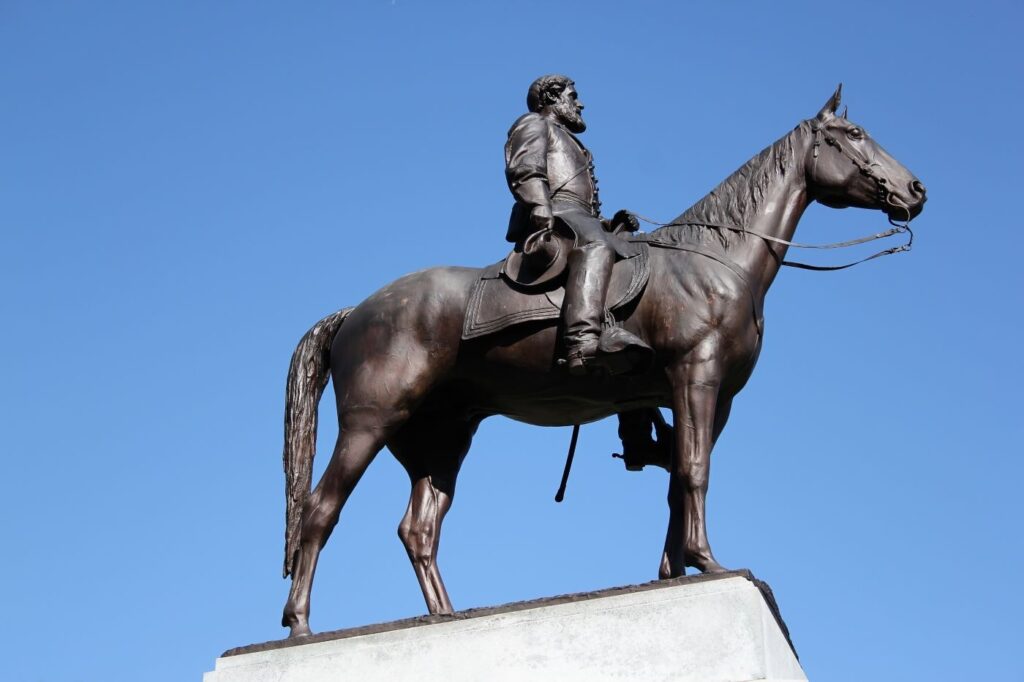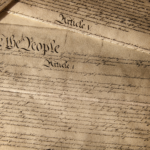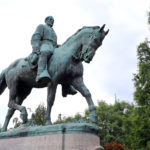This week, we are celebrating fifteen years of Public Discourse. Our contributing editors have selected their favorite essays from each of our five pillars and each day this week, we will be resharing one. We hope you enjoy this essay by Matthew J. Franck, which originally appeared in PD in August 2017.
Many years ago, as a young assistant professor in Virginia, I began to write occasionally for one of the daily newspapers in the state, contributing guest opinion columns from a conservative point of view. I had a pretty good track record of the paper accepting whatever I sent in, even though the editors were standard-issue liberal journalists. But one time—I think the only time—the paper declined to publish one of my essays was when I sent a draft on the causes and legacy of the Civil War, in which I compared Robert E. Lee to Erwin Rommel, the great field marshal of Hitler’s Third Reich.
What they had in common, I argued, was that both had served with distinction as military commanders in service to the most despicable political ideologies. But Rommel had turned against the Reich, had been implicated in the conspiracy to assassinate Hitler in 1944, and after its failure had been compelled to take his own life. Lee, however bravely he fought and whatever might be said of his conciliatory conduct after his surrender at Appomattox Court House, had stayed true to the bad cause of the Confederacy as long as it lasted.
The editors of the newspaper used good judgment when they turned down the piece. No doubt they saved me a good deal of hate mail, and a good deal of trouble from my neighbors and even my students (my liberal faculty colleagues would not have been the least bit upset). The Lee-Rommel comparison was a needless provocation on my part, evidence of a youthful taste for shocking people’s sensibilities that I have—mostly—gotten over.
Start your day with Public Discourse
Sign up and get our daily essays sent straight to your inbox.What Do Statues of Confederate Heroes Say?
To this day, admiration for Lee still runs very high in the American South. This is especially true among more conservative whites, most especially if they themselves have ancestors who fought for the Confederacy. In the South, the enduring image of Lee is that of a Christian gentleman, a gallant soldier, and one of the most brilliant generals of any age. In the terrible conflict of the Civil War, the South was outmanned and outgunned, but thanks above all to Lee, it was not out-generaled, at least not until the ascendancy of Grant and Sherman. Hence it is a natural thing for southerners to be drawn to his memory and to look up in admiration at the many statues of him that dot the region.
But what do these mute statues and monuments—to Lee, to Stonewall Jackson, to the memory of other officers and soldiers of the Confederate army—really say in their own right? That is, setting aside any disagreements over Lee the man (who died in 1870, after all)—what do the statues of Lee and the others communicate?
We may place to one side of this question those memorials and monuments that appear in southern cemeteries. There the memories of the dead are a commingling of pride, tragedy, mourning, and love of one’s own—the stuff of elegies since men began to fight wars.
But what of the heroic statuary placed in parks, on the broad avenues of southern cities and towns, in the central squares and plazas? These are the flashpoints of controversy today, and rightly so. For understood in reference to their sordid origin, these statues were meant to say to black Americans, in the voice of the unreconstructed white majority, “We’re back in charge, and don’t you forget it.”
In what other country have the vanquished been permitted by the victors to erect public monuments to their heroes? The typical Lee or Jackson statue is an artifact of the period after the collapse of Reconstruction in 1877, when white supremacists themselves became the victors in the southern states once again. Whether they propagated the “New South” mythology—the lie—that the protection of slavery had not been the cause of secession, or clung to the hard-boiled “Lost Cause” defense of slavery itself, what the ruling whites of the post-Reconstruction South had in common was a devotion to their superior political and social position, which meant keeping the black race down, by law, by privation, and by violence.
In his most recent book, the Civil War historian James McPherson offers the startling thought that when Ulysses S. Grant said “Let us have peace” in accepting the 1868 Republican nomination for president, our country “had not known real peace since the outbreak of war with Mexico in 1846.” The acquisition of new territory from Mexico had sharpened partisan discord over the potential spread of slavery, which “subsided with the Compromise of 1850 but flared up again after passage of the Kansas-Nebraska Act in 1854.” Then came “bleeding Kansas,” with hundreds dead, followed by John Brown’s raid on Harpers Ferry in 1859, itself followed by the war that cost three quarters of a million dead from 1861 to 1865, in turn followed by the disastrous administration of Andrew Johnson.
But Grant was not to have peace during his eight years as president. He constantly had to battle the Klan and other white-supremacy terrorists who kept the South in violent turmoil. “Peace,” when it came under Grant’s successor Rutherford B. Hayes after the disputed electoral-vote count of 1876, came at the price of justice for black citizens of the South, when federal troops were all withdrawn from the region. The Union was intact, and chattel slavery was gone as a legal institution, but the Jim Crow regime of segregation, subjugation, and disenfranchisement arrived with a vengeance.
That is when most of the statues of Lee and the other prominent monuments to the Confederacy and its military leaders began to become a feature of the southern landscape. Their message was unmistakable then, and should not be forgotten or whitewashed today.
Speaking Truth with Respect
All of us who have lived in the South, and many who have not lived there but have southern friends, know defenders of the Lee-Jackson-Confederacy monuments. We know defenders whom we call friends, who are reasonable people and lovers of country—of the United States, not of the Confederate States of America—and we know that such people aren’t racists. We can understand, even if at some distance, what “mystic chords of memory” (if we may borrow from Abraham Lincoln) pluck at their hearts when they think of the courage of their ancestors under the banners of the rebel South.
It can therefore feel like we are gratuitously slapping our friends in the face if we point out to them that the cause of rebellion was the cause of treason to the United States and that it was grounded in the still worse cause of perpetuating the enslavement of millions of human beings. This is why my Lee-Rommel comparison was justly rejected by those Virginia newspaper editors. It was just too hard a slap.
Yet there is truth in saying this to them. Can we respect our friends’ devotion to the memory of courageous forebears and affirm their impulse to honor their sacrifices on the battlefield? If Grant could do it—and he did—then so can we. That’s why we can and must resist the impulse to “cleanse” the whole country of all its monuments to those who fought for the South. The Confederate cemetery should be left alone, and so too, I think, should the obelisk in a small town’s square that merely names the war dead from that community (even if we wince to read, in the accompanying text, references to the glorious cause for which they fought).
But our friends of good will who wish to preserve something of all this should be willing to give up something too. That something should be the prominent statues and monuments in the great open spaces of our communities that we share with all our fellow citizens. For these are in their turn a gratuitous slap in the face of people who have felt the sting too much already. For a white Yankee like me, they’re bad enough. For black Americans, they must be intolerable. Large and forgiving natures might look on the statues now as relics of an ugly past that the country has in many ways overcome, fading into the background of noisy traffic in the modern, bustling South. But recent events in Charlottesville suggest that this overcoming is by no means a finished business. The statues should go, in order to deprive today’s feckless white supremacists of rallying points at the feet of monuments erected by yesterday’s more successful white supremacists.
The statues should go, in order to deprive today’s feckless white supremacists of rallying points at the feet of monuments erected by yesterday’s more successful white supremacists.
No Slippery Slope
For his part, President Trump is sorely mistaken to suggest that there is a slippery slope from removing Lee and Jackson statues to removing the monuments that celebrate slave-owning founders like George Washington and Thomas Jefferson. Debates about the personal morality and the political legacy of such founders are very much worth having. But the defining moments of their lives, and the pivotal causes around which they organized their political careers, were about the advancement of human freedom and progress toward the realization of equality.
These men gave us the Declaration of Independence and the Constitution, and they were leaders of the generation that built the institutions that could survive the cataclysm of the Civil War and win through to a “new birth of freedom.” Lee and Jackson, for their part, led the armies of a government that set its face against the Declaration and the Constitution, grounding itself on the claim—the “cornerstone” of the Confederacy—that the black race was inferior to the white, and that the latter should forever govern the former without its consent. Understanding the principled difference between the founding generals and statesmen of the United States—including the slave owners—and the founders and generals of the Confederate States can give us a bulwark against the slippage that President Trump evidently fears. No one ever erected a statue of George Washington in order to communicate his race’s superiority and to lord it over others.
Let us, finally, take these decisions about our public spaces and the commemoration of our past in full daylight, with solemn deliberation in civic friendship and mutual understanding, and with respectful execution of the decisions we make. Let us have no more whisking away of statues in the dead of night, as in Baltimore—as understandable as this was as an act done out of concern for public safety. “We are not enemies, but friends,” said Lincoln in 1861. “We must not be enemies.” Let us not permit a pitiable band of losers with tiki torches to turn us into enemies. But let the statues of Lee be moved to cemeteries where death belongs, and let us the living get on with the business of being fellow citizens to one another.
Image by “mgs” and licensed via Adobe Stock. Image resized.
Upon republication, our editors added a new public domain image and a pull quote. The substance of the essay remains unaltered and appears as it did in August 2017.














